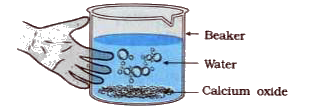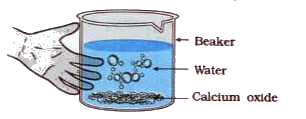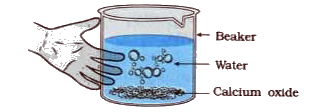A small amount of quick lime is taken in a beaker. Water is add slowly to beaker. What is the observation wre noted?Solution in Punjabi
Hissing sound an the solution becomes hot
no characteristic sound solution turns cold
Hissing sound and the solution becomes cold
No characteristic sound and the slution becomes hot.
Step by step video & image solution for A small amount of quick lime is taken in a beaker. Water is add slowly to beaker. What is the observation wre noted? by Chemistry experts to help you in doubts & scoring excellent marks in Class 10 exams.
Updated on:21/07/2023Topper's Solved these Questions
- CHEMICAL REACTIONS AND EQUATIONSBOOK - MODERN PUBLICATIONCHAPTER - CHEMICAL REACTIONS AND EQUATIONSEXERCISE - EXERCISE
141 Videos
- CARBON AND ITS COMPOUNDSBOOK - MODERN PUBLICATIONCHAPTER - CARBON AND ITS COMPOUNDSEXERCISE - EXERCISE
410 Videos
- METALS AND NON-METALSBOOK - MODERN PUBLICATIONCHAPTER - METALS AND NON-METALSEXERCISE - EXERCISE
429 Videos
Similar Questions
Translate the following statements into chemical equation and balance the equations : aluminium metal replaces iron from ferric oxide (Fe2O3) giving aluminium oxide and iron.
View SolutionWrite the chemicla formula of the simplest hydrocarbon.
View SolutionList two metals which are easy to cut .
View SolutionApparatus: Test tube, glass rod, beaker, Bunsen burner, etc. Chemicals: Hydrochloric acid, ammonia solution, magnesium strip, quick lime, etc. Activity 3: Take water in a beaker up to half of its capacity. Add a few pieces of quick lime (calcium oxide, CaO) to it. What will you observe?
View SolutionApparatus: Test tube, glass rod, beaker, Bunsen burner, etc.
Chemicals: Hydrochloric acid, ammonia solution, magnesium strip, quick lime, etc.
Activity 3: Take water in a beaker up to half of its capacity. Add a few pieces of quick lime (calcium oxide, CaO) to it. What will you observe?
View SolutionA small amount of quick lime is added to water in a beaker.
Name and define the type of reaction that has talen place.
View SolutionA small amount of quick lime is added to water in a beaker. Write balanced chemical equation for the above reaction. Write the chemical name of product obtained.
View SolutionA small amount of quick lime is added to water in a beaker.
State two observations that you will make in the reaction.
View SolutionAim: To study the reaction between calcium oxide and water. Activity: Take some quick lime (Calcium oxide - CaO) in a beaker. Add water to it slowly. Touch the beaker as shown in the figure 1.3. What is formed by reaction of quick lime with water ? Write reaction.
View SolutionAim: To study the reaction between calcium oxide and water.
Activity:
Take some quick lime (Calcium oxide - CaO) in a beaker. Add water to it slowly.
Touch the beaker as shown in the figure 1.3.

What is called the reaction occurring between quick lime and water ?
View SolutionAim: To study the reaction between calcium oxide and water.
Activity:
Take some quick lime (Calcium oxide - CaO) in a beaker. Add water to it slowly.
Touch the beaker as shown in the figure 1.3.

What do you feel by touching the beaker outside ?
View SolutionAim: To study the reaction between calcium oxide and water.
Activity:
Take some quick lime (Calcium oxide - CaO) in a beaker. Add water to it slowly.
Touch the beaker as shown in the figure 1.3.

What is slaked lime ?
View SolutionApparatus: Test tube, glass rod, beaker, Bunsen burner, etc. Chemicals: Hydrochloric acid, ammonia solution, magnesium strip, quick lime, etc. Activity 3: Take water in a beaker up to half of its capacity. Add a few pieces of quick lime (calcium oxide, CaO) to it. What will you observe?
View SolutionWater is added to quick lime in a beaker and you touch the bottom of the beaker what do you notice ? What is the reason ?
View SolutionTake a small amount of copper oxide in a beaker and slowly add dil. HCL while stirring. What is the colour of the solution ?
View SolutionStir a little beaker / calcium oxide into the water in a beaker, take a little clear solution from the beaker in a test tube and add red litmus to it. What was observed?
View Solution
